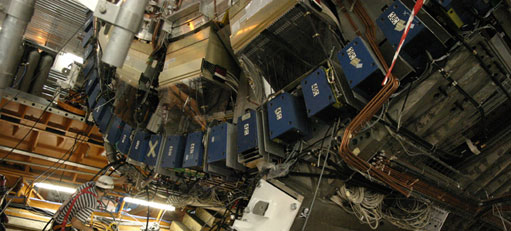
ATLAS e-News
23 February 2011
Tales out of TileCal
25 February 2009

The barrel calorimeter
A detector-builder’s work is seemingly never done, and tending to the Tile Calorimeter is no exception. The upkeep of 256 drawers stuffed full of fibres, cables and electronics is a tricky and unremitting task, according to outgoing TileCal Project Leader Bob Stanek.
“Since [the barrel] went down in 2003, we’ve been doing this job, so we’re really good at it by now,” he smiles. “But it’s still a pain.”
The drawers, which are three metres long and have a square cross section with 15-centimetre sides, are positioned in pairs, length-ways all the way around the six-metre-long barrel. Phototubes “peek out” of holes along the length of these cast aluminium structures, and register light transported by optical fibres from the scintillating tiles of the TileCal.
“We have to prioritise what needs to be fixed,” says Bob, describing the many and varied things that can, and do, go wrong with the complex machinery. The highest priority for fixing are individual drawers – which represent a whole calorimeter module – that either don’t send out data, send out corrupted data, have problems with the cooling system, or have multiple bad channels.
Slightly less urgent, but still of concern, is if an individual phototube is failing to register light, or if there are several dead electronic channels within a drawer. “If you have one dead channel – in fact if you have several channels – it doesn’t really impact on the physics,” Bob explains. “But you don’t want to let that propagate – if you have the chance to go in and fix it, then fix it.”
If only it were so simple.
At the end of each drawer, on the outer edges of the barrel (and endcaps), so-called “fingers”, containing services, power supplies, and fibres for the drawer, prevent direct access to it. These must all first be disconnected before the drawer can be slid out for closer inspection.
And the sliding itself is not necessarily straight-forward either. In a classic case of square-peg-round-hole, the position of the angular scaffolding structure prevents access to several areas of the circular end-section and needs to be carefully adjusted on an ad-hoc basis. Add to this the fact that the muon chambers are in the way, particularly on the bottom edge of the barrel, and the result is that the whole process has become much more laborious than in previous years, when the detector was incomplete.
“Last year, all 256 drawers were taken out,” says Bob, “and we got the job done in four months.” Where last year, Bob’s team were servicing two drawers per day, the current access restrictions have slowed their rate to one drawer every two days.
When possible, fixes are made with the drawer pulled just slightly out of the barrel, but when this isn’t enough, the huge 40 kilogram units are disconnected and slid out entirely, and transported down two levels in the cavern to a workbench, using an electric winch. “You have to be careful, you know, because if you ding it on something, you could break phototubes, break electronics, break other people’s detectors… and then nobody’s happy!” says Bob of the task in hand.
A local test bench, named “Moby Dick” by the crew, is used to test that the faulty components have been fixed correctly, and then again in-situ to check that nothing has been damaged while sliding the drawer back in. “And that’s a possibility!” warns Bob, “That happens! Which is why nobody’s so keen on doing [minor repairs], because you run the risk of doing more damage than it’s worth.”
The end of February presents another speed bump in the road for the repair work, as the cooling for the whole detector is off. Since the detector can’t be turned on under these conditions, the results of the local “Moby Dick” testing is all the TileCal repair team will have to go on. Full testing with the whole system in USA15 – to reveal whether all the services have been re-connected correctly – will have to wait until the detector is back up and running next month.
Despite the obstacles, the team is pushing ahead. Of the 256 modules, they have identified 25 high priority and 25 medium priority cases. Work started after ATLAS was first opened last November, and needs to be completed by the end of March. They’re currently about 40 per cent of the way through the task, which – taking into account the Christmas break – makes them just about on track.

Ceri PerkinsATLAS e-News
|